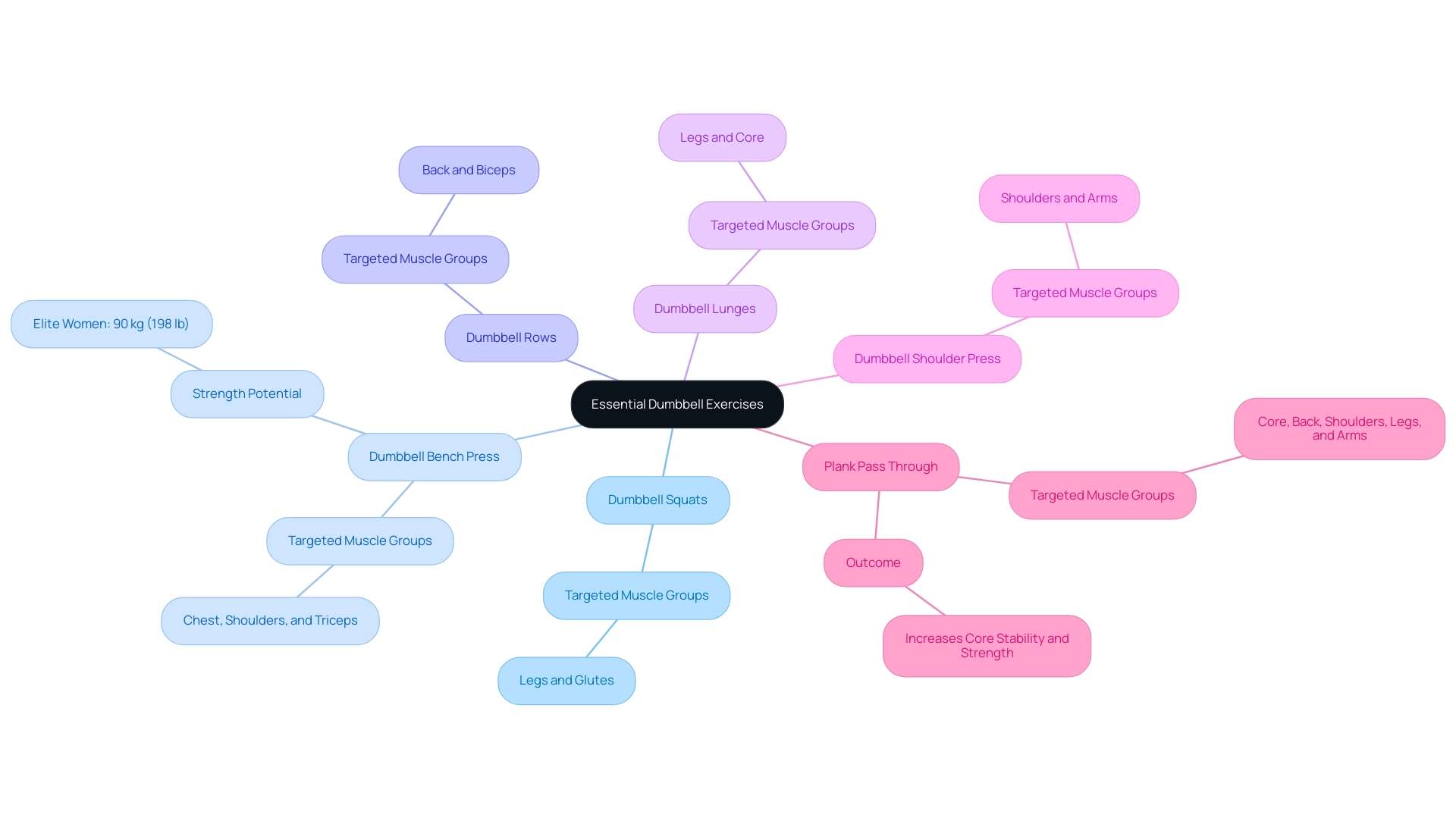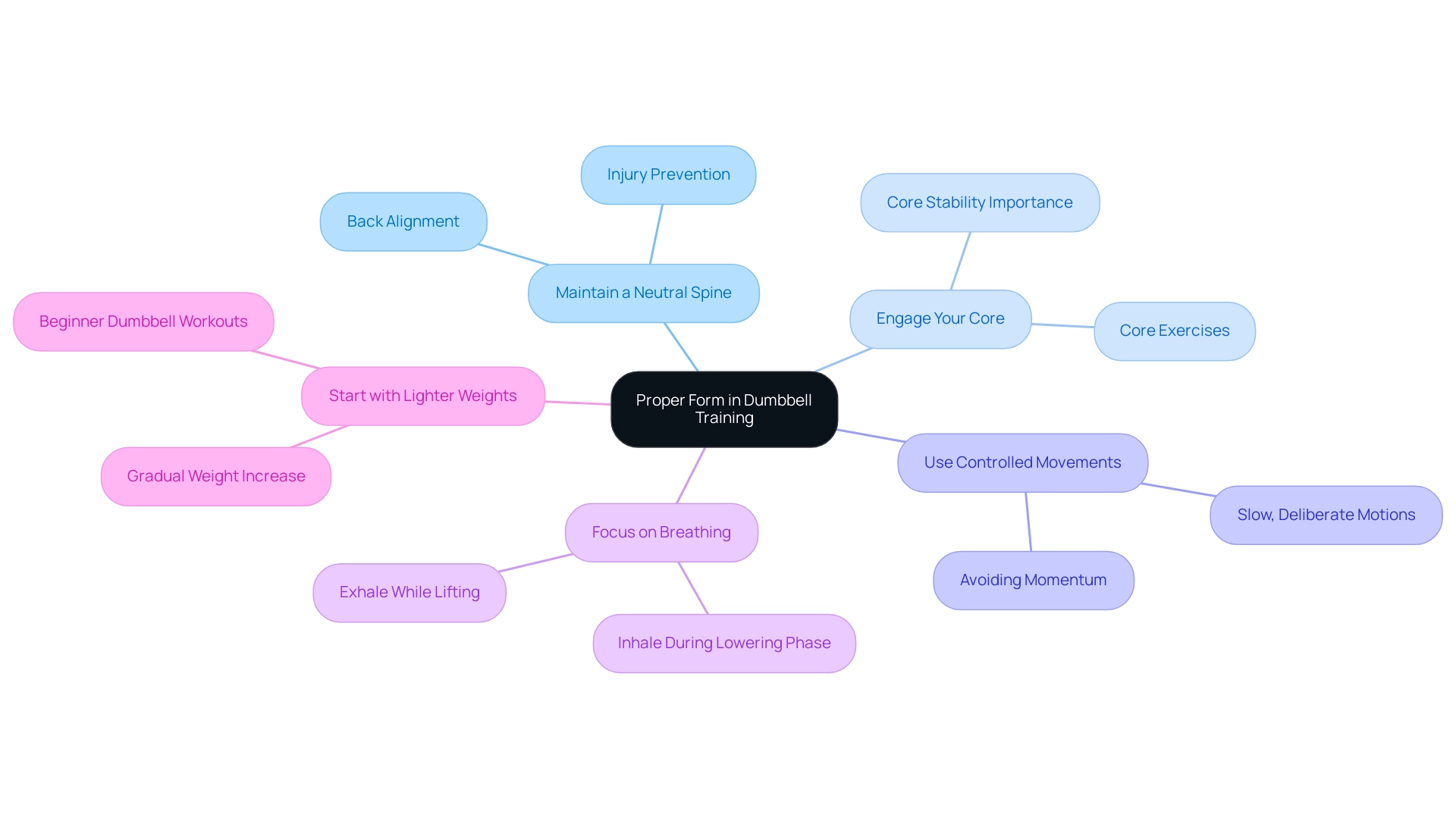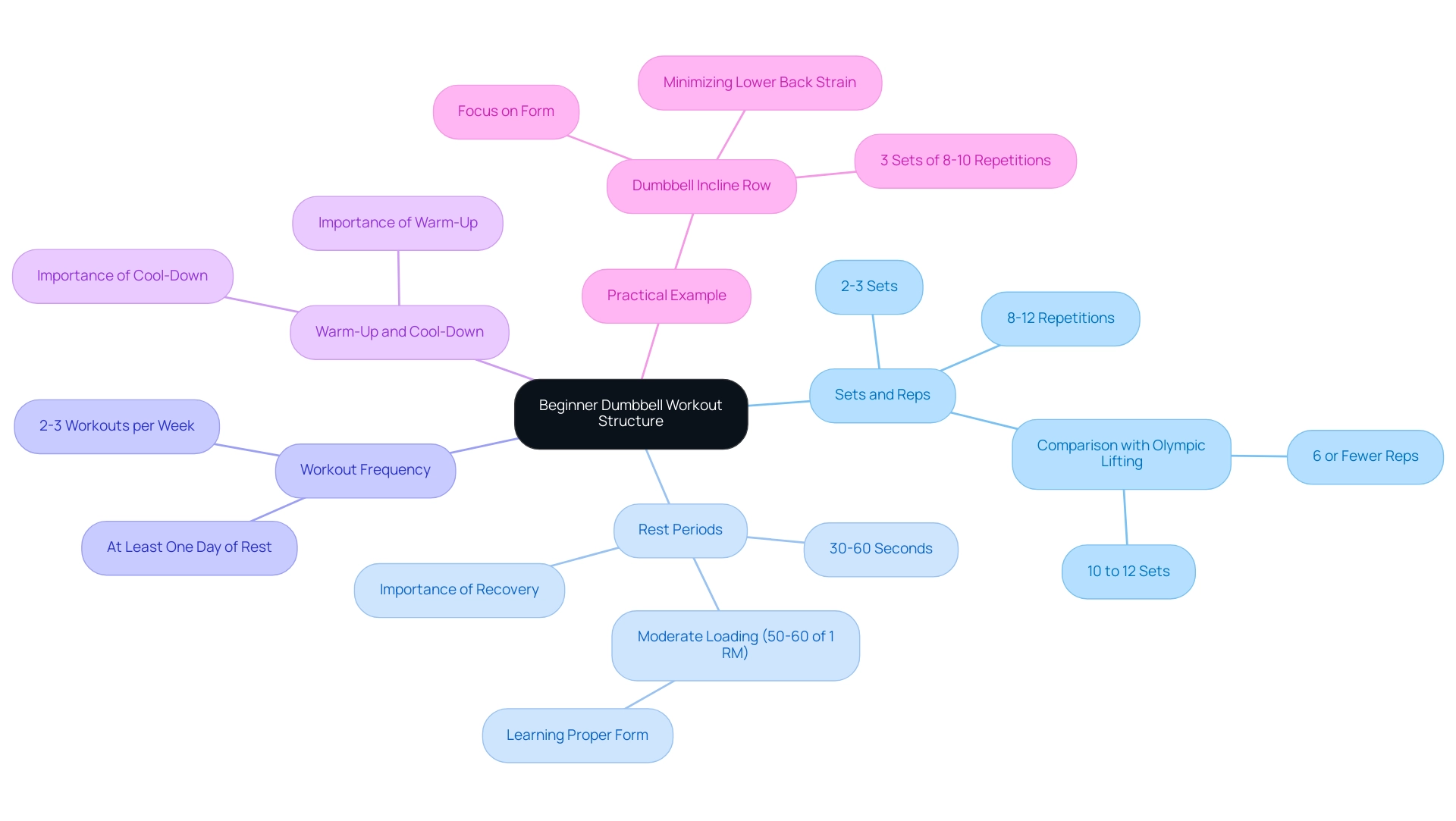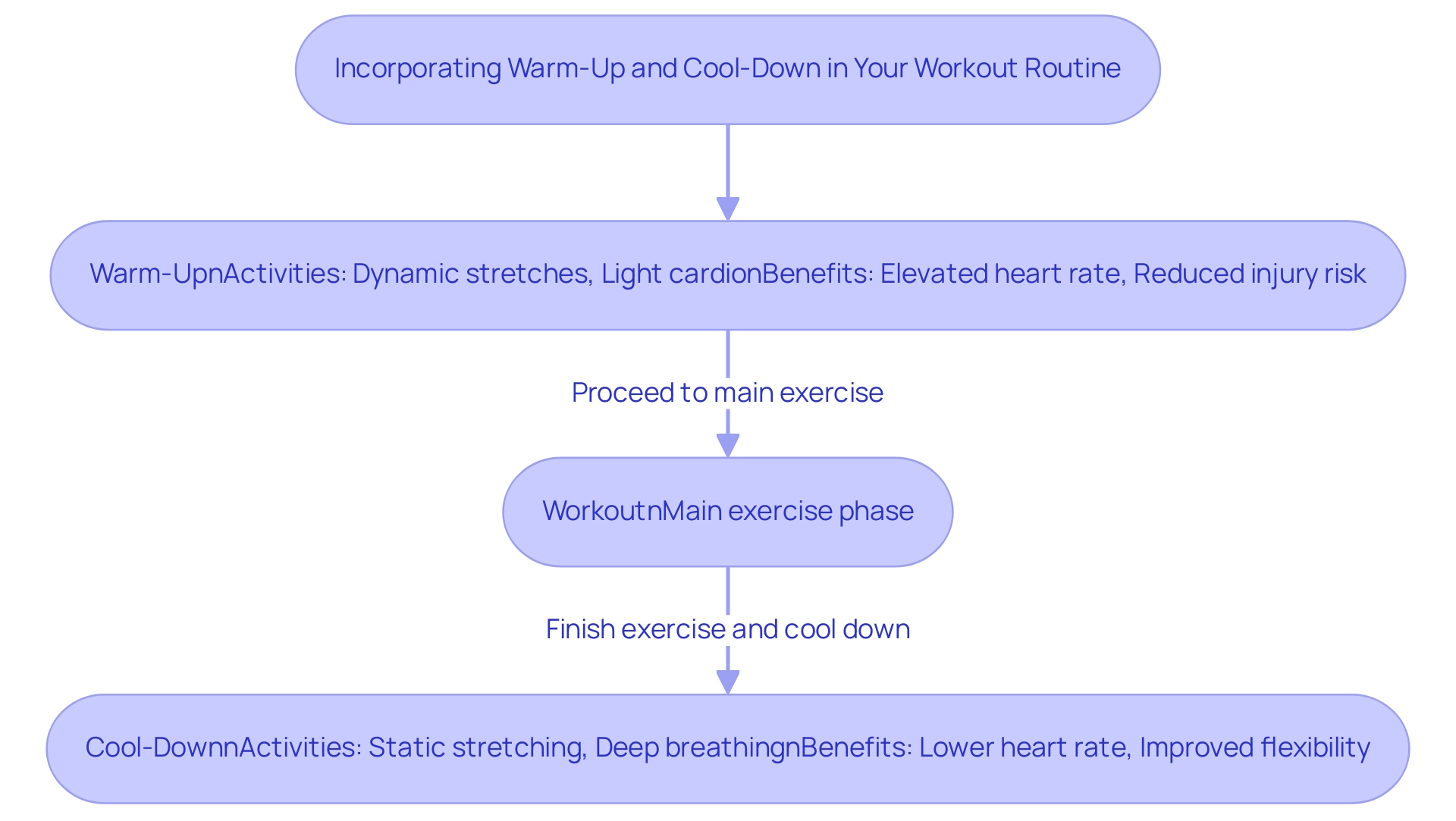Overview
A beginner dumbbell full body workout involves a series of essential exercises designed to engage multiple muscle groups effectively, promoting strength and overall fitness. The article outlines key movements such as squats, bench presses, and shoulder presses, along with proper techniques and structured guidelines for sets, reps, and rest periods to ensure safety and maximize workout benefits.
Introduction
Embarking on a fitness journey can feel overwhelming, especially for beginners. However, full-body dumbbell workouts present a remarkable opportunity to build strength and enhance overall well-being in a time-efficient manner. By engaging multiple muscle groups, these workouts not only promote physical fitness but also contribute to long-term health benefits, such as reducing mortality rates and improving quality of life. As individuals explore this guide, they will uncover essential exercises, proper techniques, and structured workout plans designed to empower them on their path to becoming stronger and healthier. The journey starts here—get ready to embrace the transformative power of strength training!
Introduction to Full Body Dumbbell Workouts for Beginners
Comprehensive dumbbell exercises create a beginner dumbbell full body workout that provides an encouraging route for newcomers to start their conditioning journey while improving overall physical fitness. These workouts engage multiple muscle groups simultaneously, resulting in a time-efficient and effective training method. According to Zatsiorsky and Kraemer (2006) in their work 'Science and Practice of Strength Training', incorporating a diverse range of movements not only builds power but also improves flexibility and endurance.
Notably, a case study titled 'Strength Training and Mortality Reduction' reveals that participating in two sessions of strength-promoting exercises each week can lead to a remarkable 23% reduction in all-cause mortality and a 31% decrease in cancer mortality rates. This highlights the significant health advantages resistance exercise can offer, particularly for older individuals. Julia Maria D'Andrea Greve, who examined the manuscript and contributed to the intellectual concept of the study, highlights the significance of such research in understanding the effects of resistance training on health outcomes.
As you explore this guide, you’ll uncover vital activities, proper techniques, and strategies to organize your workouts, including a beginner dumbbell full body workout, for maximum impact. Get ready to embrace this transformative journey toward a healthier and stronger version of yourself!

Essential Dumbbell Exercises for a Comprehensive Full Body Workout
Incorporating essential dumbbell movements into your routine is a fantastic way to engage your entire body and can serve as a beginner dumbbell full body workout to promote strength. Here are some must-try activities that target various muscle groups:
- Dumbbell Squats: This movement primarily targets your legs and glutes. Start by standing with your feet shoulder-width apart, holding a dumbbell in each hand at your sides. Lower your body as if you're sitting back into a chair, ensuring your chest remains lifted. Push back up to return to a standing position.
- Dumbbell Bench Press: A powerhouse for your chest, shoulders, and triceps. Lie on a bench with a dumbbell in each hand positioned over your chest. Lower the weights to your chest, then press them back up to the starting position. Notably, elite women can bench press 90 kg (198 lb), showcasing the potential strength gains from consistent training.
- Dumbbell Rows: This move strengthens your back and biceps. Bend at the waist with a dumbbell in each hand, pulling the weights towards your hips while maintaining a straight back.
- Dumbbell Lunges: Great for engaging your legs and core. Step forward with one leg, lowering your hips until both knees are bent at 90 degrees. Alternate legs to create a balanced workout.
- Dumbbell Shoulder Press: This activity targets your shoulders and arms. Stand or sit with a dumbbell in each hand at shoulder height. Press the weights overhead until your arms are fully extended, then lower them back to the starting position.
Additionally, consider the Plank Pass Through, a movement that engages the core, back, shoulders, legs, and arms. In this activity, you pass a weight under your body while maintaining a plank position, which increases the difficulty of the plank and enhances core stability and strength.
These movements can be mixed and matched to build a comprehensive workout routine that effectively covers all major muscle groups. Recall the advice of Peloton instructor Assal Arian:
As you start to follow your regimen and become stronger, you’ll need to make some adjustments to the weights you use.
By regularly challenging yourself with a beginner dumbbell full body workout, you’ll not only enhance your strength but also boost your overall fitness journey.
For more insights and updates, consider subscribing to receive weekly fitness updates and promotional information from Peloton.

Mastering Proper Form: Key Techniques for Safe Dumbbell Training
To ensure safety and effectiveness in your dumbbell training, mastering key techniques is essential:
- Maintain a Neutral Spine: Keeping your back straight and avoiding rounded shoulders is crucial for injury prevention. This alignment not only protects your spine but also enhances overall performance during workouts.
- Engage Your Core: Activating your core muscles stabilizes your body during activities, significantly improving balance and control. A strong core is foundational for any strength training routine.
- Use Controlled Movements: Performing each exercise with slow, deliberate motions helps prevent injuries. Relying on momentum can lead to improper form and increase the risk of strain.
- Focus on Breathing: Proper breathing techniques—inhale during the lowering phase and exhale while lifting—support performance and endurance. This practice can enhance the overall effectiveness of your workouts.
- Start with Lighter Weights: Begin your journey with a beginner dumbbell full body workout using weights that allow you to maintain proper form. Gradually increasing weight as you gain confidence and power will help avoid injuries while still challenging your muscles.
According to the Department of Health and Human Services, it is advised to participate in at least 150 minutes of moderate aerobic activity or 75 minutes of vigorous activity weekly, emphasizing the significance of including strength exercises in your fitness routine. As Nicholas Rizzo, Fitness Research Director, emphasizes, collaborating with industry leaders is key to developing effective exercise methods. Furthermore, a case study titled "Pain Management through Resistance Training" demonstrated that participants reported reduced pain levels and improved quality of life through proper training techniques.
Prioritizing proper form not only maximizes the benefits of your exercises but also minimizes the risk of injury, paving the way for a healthier, more active team.

Structuring Your Beginner Dumbbell Workout: Sets, Reps, and Rest
When designing an effective beginner dumbbell workout, it's crucial to follow some foundational guidelines that will empower you and your team to achieve their fitness goals:
- Sets and Reps: Focus on performing 2-3 sets of each exercise, aiming for 8-12 repetitions per set. This range not only facilitates strength building but is also manageable for those just starting out. Notably, Olympic lifting training sessions typically include six or fewer repetitions for about 10 to 12 sets, providing a comparative perspective on effective training strategies.
- Rest Periods: Integrate 30-60 seconds of rest between sets. This recovery period is essential for muscle recuperation and sustaining performance throughout your exercise routine, enabling individuals to push through each session with confidence. As fitness expert Dave Liepmann suggests, for novice individuals, using moderate loading (50-60% of 1 RM or less) initially is paramount for learning proper form and technique.
- Workout Frequency: Initiate with 2-3 workouts per week, ensuring at least one day of rest between sessions. This beginner dumbbell full body workout approach provides the body with essential time to adapt and recover, paving the way for sustained progress.
- Warm-Up and Cool-Down: Never overlook the importance of including a warm-up and cool-down in your routine. A proper warm-up prepares the body for the physical demands ahead, while a cool-down aids in recovery and enhances flexibility, promoting long-term health and well-being.
- Practical Example: An excellent beginner dumbbell full body workout is the Dumbbell Incline Row, which helps individuals learn proper shoulder blade movement while minimizing lower back strain. This exercise involves setting up an incline bench, using dumbbells, and performing 3 sets of 8 to 10 repetitions while focusing on form.
By adhering to these structured guidelines, combined with the Essential Coaching Plan's expert-designed, affordable curated exercises tailored for various goals and experience levels at just $67/month, you can craft an effective and safe routine that not only supports fitness aspirations but also fosters a culture of health and well-being within your team. The Essential Coaching Plan offers goal-oriented choices such as Muscle Gain, Weight Loss, Endurance, or Overall Fitness, ensuring that every participant can find a program that suits their needs. Emphasizing the importance of health will not only empower your employees but also enhance their confidence, ultimately leading to a more fulfilling work environment.

The Importance of Warm-Up and Cool-Down in Your Workout Routine
Incorporating warm-up and cool-down routines into your exercise is not just beneficial—it's essential for maximizing performance and preventing injuries.
- Warm-Up: Dedicate 5-10 minutes to dynamic stretches and light cardio, such as jogging in place. This crucial step elevates your heart rate, enhances blood flow, and prepares your muscles for the upcoming exertion, significantly reducing the risk of strains. Recent research highlights that participants who engaged in proper warm-up routines demonstrated improved performance metrics, particularly in strength and endurance activities.
- Cool-Down: After your exercise, allocate another 5-10 minutes for static stretching and deep breathing exercises. This phase is vital for gradually lowering your heart rate and improving flexibility, which aids in recovery. The cool-down group in a recent study reported VAS ratings of 7 mm (range 0–42) on day 2 and 8 mm (range 0–39) on day 3, underscoring the benefits of this practice. Moreover, a case study titled "Enhanced Athletic Performance" illustrates how stretching improves flexibility and range of motion, leading to better biomechanics and performance. As fitness expert Aaron Byzak states, "The next time you feel like you can’t spare the extra 10 minutes to cool down after running, think carefully about the effect it will have on your body. Those 10 minutes certainly seem worth it when you consider that you’re helping prevent injuries to your body, improve your performance, and aid your post-workout recovery."
By prioritizing warm-ups and cool-downs, you not only elevate your workout performance but also foster your overall health and well-being. This commitment sets the stage for long-term success in your fitness journey, benefiting not just you but your entire team as well.

Conclusion
Embarking on a full-body dumbbell workout journey offers a dynamic and efficient approach to building strength and enhancing overall fitness. By engaging multiple muscle groups, these workouts not only streamline training but also deliver significant health benefits, such as reducing mortality rates and improving quality of life. Incorporating essential exercises like:
- Squats
- Lunges
- Shoulder presses
ensures a comprehensive workout that targets various areas of the body, while mastering proper techniques safeguards against injury and maximizes results.
Structuring workouts with the right sets, repetitions, and rest periods lays a solid foundation for progress, especially for beginners. Emphasizing the importance of warm-up and cool-down routines further enhances performance and recovery, solidifying the commitment to a well-rounded fitness regimen.
Ultimately, embracing the transformative power of strength training through full-body dumbbell workouts cultivates not only physical strength but also a proactive mindset towards health and well-being. As individuals commit to this journey, they empower themselves and their teams to foster a culture of wellness that leads to lasting benefits in both personal and professional spheres. Now is the time to take action and prioritize these practices for a healthier, stronger future.
Frequently Asked Questions
What are the benefits of a beginner dumbbell full body workout?
A beginner dumbbell full body workout engages multiple muscle groups simultaneously, making it a time-efficient and effective training method. It helps improve overall physical fitness, power, flexibility, and endurance.
How does strength training impact health according to research?
Research indicates that participating in two sessions of strength-promoting exercises each week can lead to a 23% reduction in all-cause mortality and a 31% decrease in cancer mortality rates, emphasizing the significant health benefits of resistance exercise, especially for older individuals.
What essential dumbbell exercises should beginners include in their routine?
Beginners should include the following exercises: 1. Dumbbell Squats: Targets legs and glutes. 2. Dumbbell Bench Press: Strengthens chest, shoulders, and triceps. 3. Dumbbell Rows: Works the back and biceps. 4. Dumbbell Lunges: Engages legs and core. 5. Dumbbell Shoulder Press: Focuses on shoulders and arms. 6. Plank Pass Through: Enhances core stability and strength.
What is the proper technique for performing a dumbbell squat?
Stand with feet shoulder-width apart, holding a dumbbell in each hand at your sides. Lower your body as if sitting back into a chair, keeping your chest lifted, and then push back up to a standing position.
How can I organize my dumbbell workout routine?
You can mix and match the essential dumbbell exercises to create a comprehensive workout routine that effectively covers all major muscle groups. As you progress, consider adjusting the weights you use to continue challenging yourself.
What should I keep in mind as I progress with my dumbbell workouts?
As you become stronger, it's important to make adjustments to the weights you use to continue enhancing your strength and overall fitness journey.

